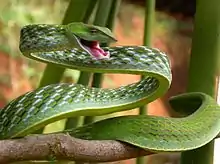| Ahaetuliinae | |
|---|---|
 | |
| Ahaetulla sp. | |
| Scientific classification | |
| Domain: | Eukaryota |
| Kingdom: | Animalia |
| Phylum: | Chordata |
| Class: | Reptilia |
| Order: | Squamata |
| Suborder: | Serpentes |
| Family: | Colubridae |
| Subfamily: | Ahaetuliinae Figueroa, McKelvy, Grismer, Bell, and Lailvaux, 2016 |
| Genera | |
The Ahaetuliinae are a subfamily of the snake family Colubridae that was erected in 2016 and comprises five genera containing 63 species (Ahaetulla [17 species], Chrysopelea [5 species], Dendrelaphis [45 species], Dryophiops [2 species] and Proahaetulla [1 species]) that are more closely related to one another than to members of the subfamily Colubrinae. Previously placed within Colubrinae, Ahaetuliinae was strongly supported as the sister group to Colubrinae in a 2016 study by Figueroa et al.[1][2]
Ahaetuliine snakes are arboreal and have keeled ventral and subcaudal scales (laterally notched in some species), and enlarged posterior grooved fangs (lacking in some Dendrelaphis).[1] The name comes from the genus Ahaetulla, which gets its name from the Sri Lankan Sinhalese language words ahaetulla/ahata gulla/as gulla, meaning “eye plucker” or “eye picker”, because of the belief that they pluck out the eyes of humans, as first reported by the Portuguese traveler João Ribeiro in 1685.[3]
Ahaetuliinae are distributed from Pakistan, through India, Sri Lanka, Nepal, and Bangladesh, throughout Southeast Asia into southeastern China, in the Philippines, the Malay Archipelago, Papua New Guinea, and northeastern Australia.[1] Most species are found in forests. Notable traits include gliding in Chrysopelea, jumping behavior in Dendrelaphis, and horizontal keyhole-shaped pupils in Ahaetulla.
Genera
- Ahaetulla (17 species)
- Chrysopelea (5 species)
- Dendrelaphis (46 species)
- Dryophiops (2 species)
- Proahaetulla (1 species)
References
- 1 2 3 Figueroa, A.; McKelvy, A. D.; Grismer, L. L.; Bell, C. D.; Lailvaux, S. P. (2016). "A species-level phylogeny of extant snakes with description of a new colubrid subfamily and genus". PLOS ONE. 11 (9): e0161070. Bibcode:2016PLoSO..1161070F. doi:10.1371/journal.pone.0161070. PMC 5014348. PMID 27603205.
- ↑ Uetz, Peter. "Ahaetuliinae". The Reptile Database. Retrieved 18 September 2019.
- ↑ Weinstein, S. A.; Warrell, D. A.; White, J.; Keyler, D. E. (2011). Venomous bites from non-venomous snakes: A critical analysis of risk and management of "colubrid" snake bites. London: Elsevier.
